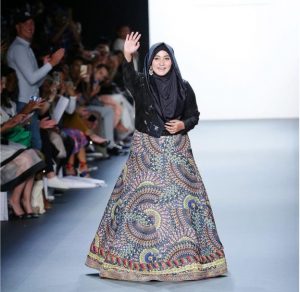NEW YORK – Models walking on New York fashion week runway in hijab have dazzled attendants at the prestigious annual event, introducing Islamic fashion in a new light and breaking down stereotypes about Muslim women.
“Behind the success of a show there is a great team that was strong and sturdy when it was hit by dissent,” Muslim designer Anniesa Hasibuan wrote on Instagram, BBC reported on Friday, September 16.
“And we can handle it.”
The hijabi show is the first by Hasibuan at the prestigious annual event.
Inspired by her hometown Jakarta, Hasibuan presented trousers, flowing tunic and gowns, in luxurious fabrics and detailed embroidery, all worn with hijabs.
The young designer, 30, received a standing ovation at the end of her show earlier this week.
Being the first in New York Fashion Week, the show was praised as a chance to break down stereotypes about Muslim women.
“I believe fashion is one of the outlets in which we can start that cultural shift in today’s society to normalize hijab in America so as to break down stereotypes and demystify misconceptions,” Melanie Elturk, chief executive of Haute Hijab, a US brand selling hijabs and modest fashion, wrote on Instagram.
“Last night’s show was a huge leap forward in that direction.”
Islam sees hijab as an obligatory code of dress, not a religious symbol displaying one’s affiliations.
Modesty and religion are the cornerstones behind the fast-growing Islamic fashion industry, which is making a mark on runways from Indonesia and Dubai to Monte Carlo.
Islamic fashion is part of a growing appetite for Shari`ah-related industries and assets, ranging from finance to halal food.
High-end brands such as Dior, Dolce & Gabbana, Donna Karan New York, as well as high street stores like Zara and Uniqlo, are known for releasing Ramadan or `Eid collections in countries with large Muslim population.
Indonesian Touch

Anniesa Hasibuan only entered the world fashion scene last year
Over the past years, Indonesia has popped up as an innovator in the region for modern Islamic dress.
“Indonesian fashion has become more diverse and we’ve become more confident in taking our own culture and what we’ve grown up with into our influences,” Putri Soediono, a Singapore-based designer with Indonesian heritage, told BBC.
Soediono thinks Hasibuan has proven that Islamic wear can be fashionable, not just the plain black Arab-style burqa that people think of, and that there is talent in Indonesia.
However, many groups in Indonesia criticized these clothes as “not Islamic enough”.
“The essence of Muslim dress is to wear something decent, to be modest. For women they have to make sure what they’re wearing doesn’t attract the attention of men,” said Dr Eva Nisa, professor of Islamic Studies at Victoria University, who has been researching Muslim fashion in Indonesia since 2007.
“Some people think what the Muslim fashion designers produce is totally against this kind of religious doctrine [because it can be seen to attract attention].”
Yet, many regarded the Islamic hijab as a part of Muslim women identity which they are asserting more confidently.
Hasibuan “started her career designing for Muslim women – this is what her consumers want,” said Soediono.
“We just want to design for ourselves, what we like to wear.”
Indonesia is the fifth biggest market for Muslim fashion, after Turkey, United Arab Emirates, Nigeria and Saudi Arabia.
Meanwhile, China, India and Turkey are the three biggest exporters of Muslim fashion.
Experts predict the industry to grow to more than $300 billion dollars by 2019.
